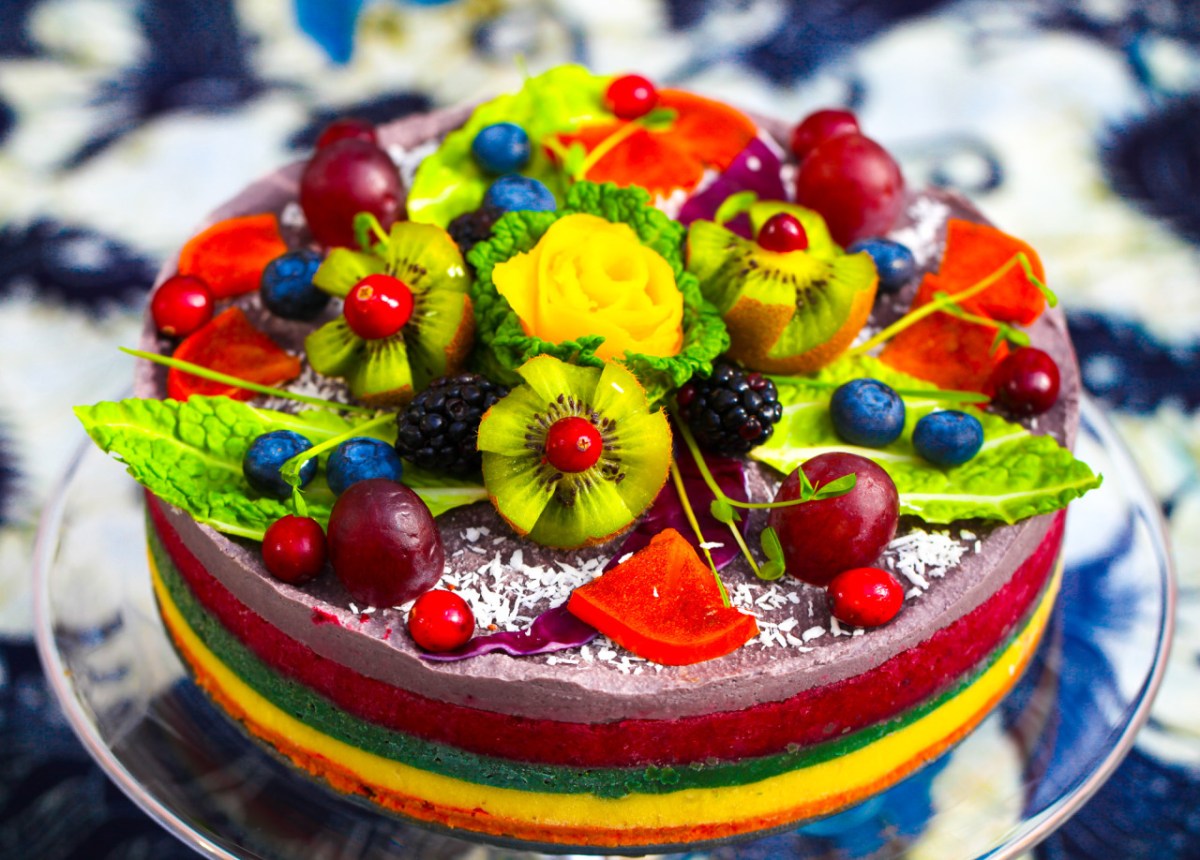Imagine a world where decadent, delicious cakes are not only stunning centerpieces but also entirely plant-based. This isn’t a dream; it’s the reality of vegetarian cakes, perfect for birthdays, weddings, anniversaries, or any celebration you can imagine. From the velvety richness of chocolate to the bright zest of citrus, these cakes offer a symphony of flavors and textures, proving that deliciousness knows no dietary boundaries. Prepare to be inspired by a vibrant array of recipes, stunning decorating ideas, and foolproof baking techniques that will transform your next gathering into a truly unforgettable event.
This exploration delves into the art of crafting exquisite vegetarian cakes, guiding you through selecting the perfect recipe, mastering essential techniques, and presenting your creations with flair. We’ll uncover the secrets to achieving a flawless crumb, explore diverse frosting options, and offer creative serving suggestions to elevate your culinary artistry. Whether you’re a seasoned baker or a kitchen novice, this guide provides the knowledge and confidence to bake show-stopping cakes that will delight everyone, regardless of dietary preferences.
Popular Vegetarian Cake Types
Vegetarian cakes offer a delightful array of flavors and textures, perfectly suitable for any celebration. From rich chocolate decadence to light and fruity delights, there’s a vegetarian cake to satisfy every palate and occasion. This section explores five popular choices, detailing their ingredients, flavor profiles, and creative decorating ideas.
Five Popular Vegetarian Cake Types and Their Flavor Profiles
The following list details five popular vegetarian cake types, highlighting their key ingredients and characteristic flavors. Each cake offers a unique sensory experience, making them ideal for a variety of celebratory events.
- Chocolate Fudge Cake: This classic boasts a deeply intense chocolate flavor, achieved through the use of cocoa powder, melted dark chocolate, and a touch of espresso powder for complexity. Its moist crumb and rich frosting make it a crowd-pleaser.
- Carrot Cake: A beloved springtime favorite, this cake features grated carrots, warm spices like cinnamon and nutmeg, and often pineapple for a touch of sweetness and tang. The creamy cream cheese frosting complements the cake’s earthy sweetness.
- Lemon Poppy Seed Cake: This light and zesty cake offers a refreshing alternative to richer options. The bright citrus notes of lemon zest and juice are balanced by the subtle crunch of poppy seeds. A lemon glaze or buttercream frosting enhances its vibrant flavor.
- Red Velvet Cake: Known for its vibrant crimson hue and tangy flavor, this cake typically uses buttermilk, cocoa powder, and red food coloring. The cream cheese frosting is essential, adding a creamy counterpoint to the cake’s slightly acidic taste.
- Vanilla Bean Cake: This elegant cake showcases the pure, delicate flavor of vanilla beans. High-quality vanilla extract or paste is key, providing a rich and complex aroma and taste. Its versatility makes it a perfect base for various frostings and decorations.
Decorating Ideas for Vegetarian Cakes
The right decoration can transform a simple cake into a celebratory masterpiece. Here are three unique decorating ideas for each cake type, suitable for different occasions.
- Chocolate Fudge Cake:
- Birthday: A cascade of chocolate ganache, adorned with fresh raspberries and chocolate shavings, creates a luxurious look.
- Wedding: A sleek, fondant-covered cake with delicate sugar flowers and edible gold leaf adds an air of sophistication.
- Anniversary: A rustic, semi-naked cake with a drizzle of chocolate ganache and fresh berries provides a charming, romantic feel.
- Carrot Cake:
- Birthday: A whimsical design featuring carrot-shaped cookies and cream cheese frosting swirls adds a playful touch.
- Wedding: An elegant cake with a smooth cream cheese frosting, decorated with delicate sugar flowers and piped buttercream details.
- Anniversary: A rustic, layered cake with cream cheese frosting and toasted pecans, offering a warm and inviting aesthetic.
- Lemon Poppy Seed Cake:
- Birthday: A bright and cheerful cake decorated with lemon curd swirls, candied lemon slices, and poppy seeds.
- Wedding: A sophisticated cake with a smooth lemon buttercream frosting, adorned with edible flowers and delicate sugar work.
- Anniversary: A simple yet elegant cake with a lemon glaze and fresh berries, representing a fresh and joyful celebration.
- Red Velvet Cake:
- Birthday: A funfetti-style cake with colorful sprinkles and cream cheese frosting rosettes adds a festive touch.
- Wedding: A classic red velvet cake with smooth cream cheese frosting and delicate lace details creates an elegant atmosphere.
- Anniversary: A heart-shaped cake with a cream cheese frosting and fresh strawberries, symbolizing love and romance.
- Vanilla Bean Cake:
- Birthday: A vibrant cake decorated with colorful buttercream flowers and edible glitter, adding a touch of sparkle.
- Wedding: A minimalist cake with a smooth vanilla buttercream frosting, adorned with fresh flowers and elegant sugar work.
- Anniversary: A simple, elegant cake with a vanilla buttercream frosting and fresh berries, representing a classic and timeless celebration.
Nutritional Comparison of Vegetarian Cake Types
Nutritional values are approximate and can vary based on specific recipes and ingredients. These values represent a single serving (approximately 1/12th of a standard 9-inch cake).
| Cake Type | Calories (approx.) | Protein (approx. g) | Fat (approx. g) |
|---|---|---|---|
| Chocolate Fudge Cake | 350-400 | 4-5 | 20-25 |
| Carrot Cake | 300-350 | 3-4 | 15-20 |
| Lemon Poppy Seed Cake | 280-320 | 3-4 | 12-18 |
| Red Velvet Cake | 320-370 | 4-5 | 18-23 |
| Vanilla Bean Cake | 250-300 | 3-4 | 10-15 |
Recipe Variations & Adaptations
Transforming a basic vegetarian cake recipe into a delectable masterpiece is a journey of culinary exploration, where simple adjustments unlock a world of flavor and texture. By thoughtfully altering ingredients and techniques, you can effortlessly adapt a single recipe to suit any occasion and palate. This section will delve into the art of customizing vegetarian cakes, covering flavor variations, flour choices, and frosting options.
Flavor Variations
Adding depth and complexity to a vegetarian cake’s flavor profile is surprisingly simple. A basic vanilla cake, for instance, can be easily transformed into a rich chocolate cake by incorporating cocoa powder. The addition of 1/4 cup of unsweetened cocoa powder to a standard vanilla cake batter will create a deep, dark chocolate flavor. For a lighter chocolate cake, reduce the cocoa powder to 2 tablespoons. To infuse fruity notes, consider adding pureed fruits like blueberries, raspberries, or strawberries directly into the batter. The fruit puree will add moisture and a vibrant burst of flavor. A lemon zest and juice addition, on the other hand, creates a bright, zesty cake. The subtle citrus notes complement both vanilla and chocolate bases beautifully. For a more intense flavor, try using lemon curd as a filling or swirling it into the batter.
Flour Type Impact
The choice of flour significantly influences the texture and taste of a vegetarian cake. All-purpose wheat flour, a common choice, provides a familiar, slightly soft crumb. Substituting all-purpose flour with almond flour results in a denser, more delicate cake with a subtly nutty flavor. Almond flour cakes often require a slightly increased amount of liquid to achieve the desired consistency. Oat flour, on the other hand, produces a moist, hearty cake with a slightly grainy texture and a subtle oat flavor. Oat flour cakes benefit from the addition of binding agents like applesauce or mashed banana to maintain structure. The choice of flour depends entirely on the desired texture and taste profile; each offers a unique contribution to the overall sensory experience.
Frosting Options
Three popular frosting options for vegetarian cakes offer distinct textures and flavors: classic buttercream, cream cheese frosting, and vegan chocolate ganache. Classic buttercream, made with butter, powdered sugar, and vanilla extract, provides a smooth, creamy, and rich texture. The preparation involves creaming softened butter with powdered sugar gradually, adding vanilla extract and milk or cream for desired consistency. Cream cheese frosting offers a tangy, less sweet alternative, created by beating softened cream cheese with powdered sugar and vanilla extract until light and fluffy. This frosting is exceptionally well-suited for carrot cakes and other spice cakes. Finally, a vegan chocolate ganache, made by combining melted dark chocolate with plant-based cream (like coconut cream or cashew cream), delivers a decadent, intensely chocolatey experience. The ganache sets to a smooth, rich, and intensely flavorful frosting. The choice depends on the desired flavor profile and the overall cake design.
Step-by-Step Baking Guide for a Signature Cake

This guide details the creation of a decadent, moist, and utterly delicious Chocolate Avocado Cake, a surprisingly rich vegetarian option perfect for any celebration. The avocado adds incredible moisture and a velvety texture, while remaining undetectable in the final product. The recipe emphasizes achieving a perfect, light crumb through careful mixing techniques.
Ingredients
This section lists the ingredients needed for the cake and the chocolate ganache frosting. Precise measurements ensure consistent results.
- For the Cake: 1 ½ cups all-purpose flour, ¾ cup unsweetened cocoa powder, 1 ½ teaspoons baking powder, ¾ teaspoon baking soda, ¾ teaspoon salt, 1 ½ cups granulated sugar, ¾ cup vegetable oil, 2 large ripe avocados, mashed, 2 teaspoons vanilla extract, 1 cup almond milk, 2 large eggs.
- For the Chocolate Ganache: 1 cup heavy cream, 8 ounces semi-sweet chocolate, chopped.
Cake Preparation: Dry and Wet Ingredients
Preparing the dry and wet ingredients separately is crucial for achieving a light and airy cake. This prevents overmixing, which can lead to a tough crumb.
- In a large bowl, whisk together the flour, cocoa powder, baking powder, baking soda, and salt. This ensures even distribution of leavening agents.
- In a separate bowl, combine the sugar, oil, mashed avocados, vanilla extract, almond milk, and eggs. Whisk until well blended. The avocado will create a smooth, creamy base.
Combining Ingredients and Baking
This stage focuses on gently incorporating the wet ingredients into the dry, avoiding overmixing. The resulting batter should be smooth but not over-beaten.
- Gradually add the dry ingredients to the wet ingredients, mixing on low speed with an electric mixer until just combined. Overmixing develops gluten, resulting in a tough cake.
- Pour the batter into two greased and floured 9-inch round cake pans. Evenly distribute the batter for consistent baking.
- Bake in a preheated oven at 350°F (175°C) for 30-35 minutes, or until a toothpick inserted into the center comes out clean. The baking time may vary slightly depending on your oven.
Cooling and Frosting
Allowing the cakes to cool completely before frosting is essential to prevent the frosting from melting. The ganache should be allowed to cool slightly to achieve a spreadable consistency.
- Let the cakes cool in the pans for 10 minutes before inverting them onto a wire rack to cool completely. This prevents them from sticking and ensures even cooling.
- For the Ganache: Heat the heavy cream in a saucepan over medium heat until it just begins to simmer. Pour the hot cream over the chopped chocolate and let it sit for a few minutes. Then, whisk until smooth and glossy. Allow the ganache to cool slightly until it thickens enough to spread.
- Once the cakes are completely cool, frost the top of one layer with the ganache and carefully place the second layer on top. Frost the entire cake with the remaining ganache.
Achieving a Perfect Cake Crumb: Mixing Techniques
The key to a light and tender crumb lies in gentle mixing. Overmixing develops gluten, leading to a tough texture. The creaming method, used here, incorporates air into the batter, resulting in a light and airy cake. The batter should be smooth, but not over-mixed. Visual cues include a batter that is slightly lumpy, rather than completely smooth. A slightly under-mixed batter will produce a better texture than one that is over-mixed.
From the initial flour sifting to the final celebratory slice, baking a vegetarian cake is a journey of culinary creativity and delicious results. We’ve explored a spectrum of flavors, techniques, and presentation ideas, empowering you to craft cakes that are as unique and memorable as the occasions they celebrate. Remember, the key is not just in the recipe but in the joy of creating something beautiful and delicious to share with loved ones. So, gather your ingredients, embrace the process, and let your imagination run wild as you embark on your next cake-baking adventure. The possibilities, like the flavors themselves, are truly endless.
FAQ Guide
Can I freeze vegetarian cakes?
Yes, many vegetarian cakes freeze well. Wrap them tightly in plastic wrap and then foil before freezing for up to 3 months. Thaw completely before serving.
What are some good substitutes for eggs in vegetarian cakes?
Applesauce, mashed banana, flax eggs (flaxseed meal mixed with water), or silken tofu can all successfully replace eggs in vegetarian cake recipes, each offering slightly different textural results.
How can I make my vegetarian cake more moist?
Adding a touch of oil or sour cream to the batter helps retain moisture. Using a simple syrup to brush over the cake after baking also adds extra hydration.
How long can I keep a vegetarian cake at room temperature?
Ideally, keep unfrosted cakes refrigerated and frosted cakes at room temperature for no more than 2-3 days. Refrigerate leftovers to maintain freshness and prevent spoilage.


